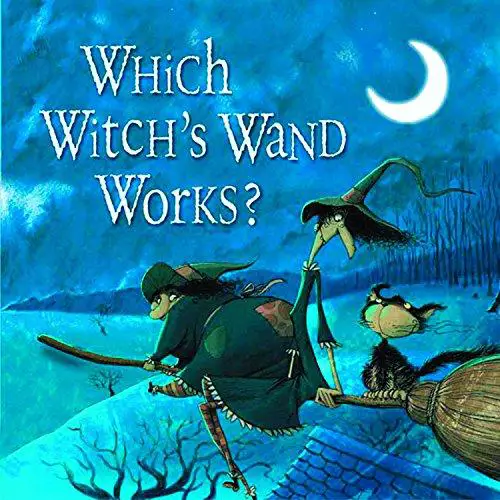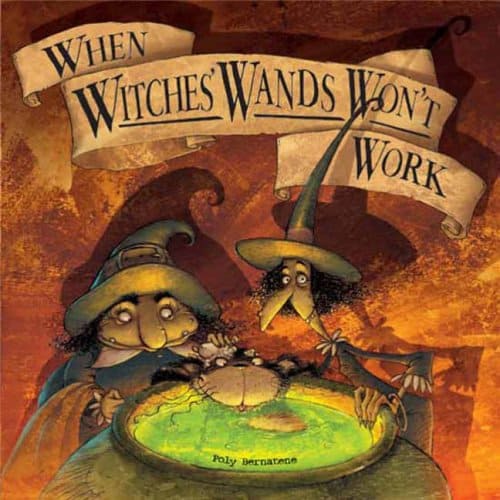Which Witch’s Wand Works? is a 2004 carnivalesque picture book in which two sister witches are the stand-ins for children.

Alliteration features strongly in this story — not only do we have the title of the book (and of the fictional TV show they argue over), but also the names of the main characters, Rattle, Ricket and Rum. The original characters are named ‘Paca’, ‘Poca’ and ‘Espantoso’, which means ‘Dreadful’. So I feel something has been lost in the translation from Spanish to English. The cat’s name in Spanish is obviously ironic, as the cat is harmless. I wonder at the translator’s decision to name him ‘Rum’?
In these two sisters you have the tall skinny one and the short, fat one. This same duo can be seen in Kate DiCamillo’s Mercy pig series, in which the short fat one seems like she has a developmental disability while the taller skinny one acts as ‘Mother’, and is no fun at all. We don’t have that dynamic going on here, though; both of the sisters are equally childlike.
STORY STRUCTURE OF WHICH WITCH’S WAND WORKS?
SHORTCOMING
Rattle ‘has trouble flying in very strong winds’.
Ricket ‘has trouble flying at all’.
Rum ‘would rather walk’.
In this way, we are told directly what is wrong with each of the main characters as we are introduced on the first page. These witch characters are looking out of the page at us as if they’ve been caught ‘in the act’. One is stuck up a tree; another is on the floor of the living room and the cat laughs.
These shortcomings are specific incidents; overall, we see that although they are witches, they are not good at their jobs.
DESIRE
On page two we learn that each sister would like to prove herself superior to the other.
OPPONENT
The other sister.
PLAN
They start a contest to see who can do better magic with her wand.
BIG STRUGGLE
The spells they cast on each other get them into silly positions. Eventually one of them inadvertently disappears down the road in the back of a dustcart. ‘Rattle jumped on her broomstick and flew out the window in hot pursuit’. She unglamorously lands on the windscreen of the dustcart and rescues the cat.
The struggle sequence in a picturebook often occupies a large portion of the book and is often paced just as this one is:
- First incident (witch turns into ‘frog’ – actually a green witch)
- Second witch is supposed to shrink (but actually blows up into a balloon and flies around)
- First witch makes her sister disappear (but actually she’s outside clinging to a flagpole)
- And after those three incidents (note the rule of threes), we have a double spread of multiple incidents, speeding up the pace. ‘The witches carried on and the spells flew back and forth.’ This speeds up the pace and we understand this big struggle went on for a while.
- The worst thing happens overleaf. Because we’ve just had an entire sequence of mayhem depicted on the same double spread, this single event occupying a single double spread is emphasised.
ANAGNORISIS
There is no self revelation, but they are overjoyed to get their cat back, and decide to have a party.
NEW SITUATION
The book conspicuously ends ‘back where we started’, in their carnivalesque house, where no one has any more self knowledge, leaving plenty of room for this pair of hopeless witches to get into further trouble later.

NOTES ON THE ILLUSTRATION
Witches are characters from medieval times, so a story starring witches lends itself well to some illustrative techniques of yore. In this book we have a very modern style — full colour, opacity variations, blurred silhouettes which mimic the effect of a modern SLR camera, texture overlays, expressive caricature, and many different ‘camera angles’ — but we also have these full colour illustrations contrasted against black and white line drawings. Before the modern printing era, this was often done in books to reduce printing costs, but these days it has a different function. There’s the effect of making the book seem older, but I don’t think it’s just that. The black and white illustrations convey information, but they are not designed for the eye to linger upon.
For instance, in the double spread where we see the cat crying out from the back of the dust truck, the black and white witch looks on in horror. We are not meant to focus on the witch; we are meant to follow her gaze. The cat, of course, is in full colour. We are to focus on the cat and the misery of being taken away from home to goodness knows where.
NOTES ON THE NARRATION
This picturebook makes use of an interesting technique: regular parenthesis. It’s a form of authorial ‘intrusion’, of course, but this is the unseen narrator guiding the young reader through the story with a wink wink, nudge nudge.
